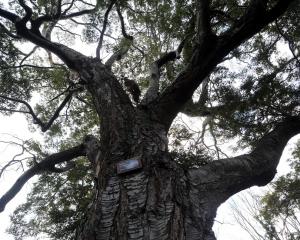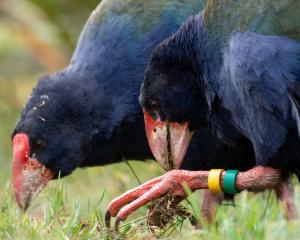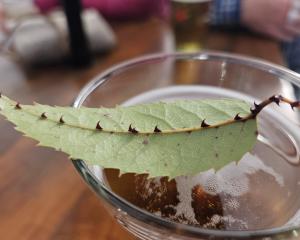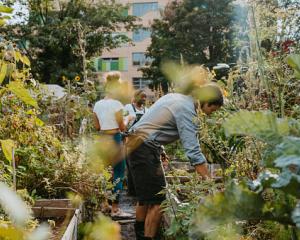Giving clothes a second life, or adding some personal touches, makes them that much more special for longer, say the clever people picking up needles and thread.
 Georgina, Tom (10) and Nina
Keeping it in the family
Georgina, Tom (10) and Nina
Keeping it in the family

I made this dress for my sister, Nina, with some help from Mum.
Mum’s really into mending and bringing new life to things, so we go to Stitch Kitchen to do sewing.
The top of the dress is from a friend of Mum’s. It was part of her daughter’s dress, which had become too small, so they made it into a skirt. I used the leftover top part.
The bottom part of Nina’s dress is made from a short skirt of Mum’s that did not fit any more.
The materials weren’t a perfect match but were close enough.
I sewed them together, with some help.
It was Nina’s idea to add the flowers, as it was a bit plain.
The flowers were from a scrapbook-making kit, and Nina chose orange thread to look like nectar.
All together, it only took about an afternoon to sew.
It is the planning that takes most of the time, thinking about the idea, what will go with what and how we will do it.
You need to have the picture of how you want it.
It is quite sad how so many people used to know how to sew but now it is dying out.
I enjoy it. I think I like anything that makes your mind interact with your fingers.
Nina wears the dress a lot, which is cool when you think that otherwise it would have gone to landfill.
 Kirsten Koch
Vintage Style
Kirsten Koch
Vintage Style

I’ve had this jersey for about 15 years, after picking it up while volunteering as a sorter with the Salvation Army. I think it is a retro ’80s number with the slight batwing sleeves. You could get quite a few finds at that stage if you put in the hours, but it is hard to find vintage at a cheap price any more. I thought this jersey was worth the work to repair and make even better; kind of like working on myself.
I absolutely love second-hand adornment, costume and sewing materials, which I collect, favouring materials such as wool, silk, lace and beads. I love doing beadwork and other hand-sewing methods especially for myself but also for other people I care for. The cream wool in this jersey looks warm and cosy and then the beadwork looks quite lacey and dressy, I like that effect. It is a bit Christmassy too.
I had noticed there were these small moth holes appearing all over the place and over time and use, even the original beadwork needed some reattaching. I’ve embroidered this with a mixture of second-hand embroidery threads, some from my great aunties’ sewing equipment which I inherited (two great aunties). I did it because I thought it has had so much care and attention put into it to begin with and I value that work.

 Shona McKee
More than the sum
Shona McKee
More than the sum

Coming from a textiles and garment construction background as a teacher and designer I have always loved making my own clothes.
When I am tired of a garment I often recycle it by deconstructing and adding embellishments to make a new design that makes me want to wear it again. It is also fun and satisfying but it is important to use quality natural fibres (cotton, linen, wool or silk) to make it worthwhile for your efforts. I have recycled several jackets and often replaced linings as well.
The denim jacket I am wearing was originally made more than 15 years ago. To change the jacket from a formal look with piping and zippered front I cut all the piping out, leaving frayed edges. I cropped the jacket by cutting it off at the waist and left it to fray. This fabric was used to create two front breast pockets. The zip was removed and bands down the centre front were added with some recycled buttons. The zip was used around the collar edges and another long metal zip was used for the embellishment at the back. The entire jacket was topstitched in gold thread to finish.
 Bruno Willis (aka Florian Longshanks)
Standing tall
Bruno Willis (aka Florian Longshanks)
Standing tall

Florian Longshanks is a stilt-walker with an interest in recycling. He made the red coat from two women’s coats from a free clothing collection point; the sleeves of one he adjusted and fitted on to the larger body of the other, while the remaining fabric made the tails. The embroidered edging came from an old curtain and the white was a torn piece of bedding. The epaulets on the shoulders are the soles of worn-out felt slippers. The leather was tough so to get the thread through he had to drill holes with an electric drill. The jeans too were repaired, though mainly on the back where the worst rips were. To make the repairs subtle, Florian Longshanks unpicked the leg seams. He then cut up other jeans that were worn out worse and cut pieces to match holed sections of the good jeans. He cut off the worn bits and replaced them with new cut-outs, then stitched it all back up. The jeans look like they were made with the patches in the first place, but unfortunately the original denim is still falling apart, and will need another repair soon.












